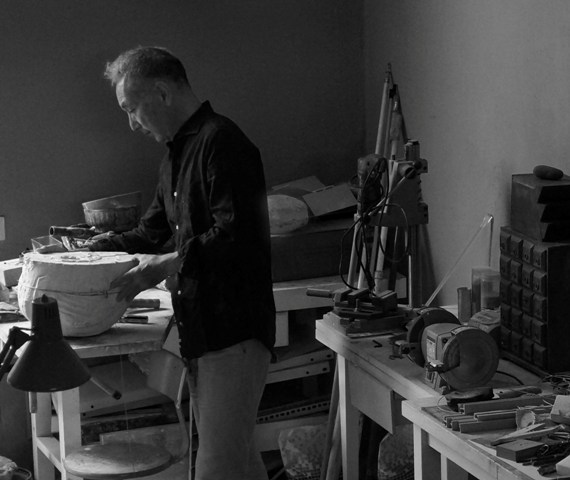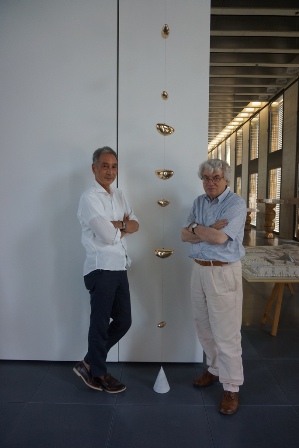![]()
![]()
Opere (Works):
via Francesco Nullo, 19 20129 Milano - Italy
+39 02 7384961 (home) +39 349 8621455 (mobile)
e-mail : ky.nagatani@tiscali.it
"SEME del TEMPO"
di Kyoji Nagatani
" c'è un soffio leggero del tempo dietro le opere di Nagatani;
sussiste una presenza del passato che interroga l'osservatore."
Mario Botta 2015
_______________________________________________________________________
"SEED of TIME"
di Kyoji Nagatani
" there is a soft breath of time behind Nagatani's work;
a presence of the past that constantly interrogates the observer."
Mario Botta 2015
SEME DEL TEMPO
Mario Botta giugno 2015
Per interpretare
correttamente l’opera scultorea di Nagatani è indispensabile richiamare la
sensibilità e la partecipazione attiva dell’osservatore.
Nella maggior parte dei
casi, infatti, le sue opere si presentano come frammenti di una realtà più
ampia e misteriosa. Come appare talvolta anche nei titoli delle sue opere, le
sculture si presentano come “semi”, elementi primordiali con potenzialità
ancora inespresse, con realtà nascoste tutte da scoprire. È possibile trovare
forti analogie fra queste opere e la nozione di fertilità: c’è un soffio
leggero del tempo dietro le opere di Nagatani; sussiste una presenza del
passato che interroga con insistenza l’osservatore. Questa è una affascinante
chiave di lettura del lavoro dell’artista.
Il “tempo” è evidentemente
una realtà esterna alla scultura, ma diviene una nozione di riferimento nel
momento in cui avviene l’incontro con l’osservatore.
Mi sembra di capire che le
opere modellate da Nagatani (anche quando sono ingrandite per divenire
monumentali) conservano principalmente la capacità di apparire come parti
limitate, talvolta microscopiche, rispetto a una realtà di tempo e di spazio evocata
dall’artista.
Di fronte a questi lavori
l’immaginario dell’osservatore è sospinto verso una dimensione cosmica; le
sculture si configurano come atomi rispetto alla materia, o cellule a confronto
dei tessuti, o stelle come parti delle galassie. Le sculture si proiettano come
messaggi nell’indecifrabile mistero proprio della forza creativa.
Il registro linguistico
dello scultore insiste sulla dualità di trattamento fra le parti levigate delle
superfici esterne che avvolgono il volume primario – chiare e sensuali – e
l’accentuata rugosità di una materia grezza e cruda, ancora viva, interna al corpo
modellato, con lacerazioni e ferite create dal processo
generativo. I rimandi alla realtà dei messaggi evocati dall’artista, i silenzi
e le profondità di spazio e di tempo, sono custoditi nel grembo tormentato
della scultura.
Le forme espressive di Nagatani
vivono un rapporto di tensione continua fra fragili equilibri, la condizione
emotiva dell’osservatore diviene parte dell’opera stessa. Le sculture si
affermano come segni che evocano nel silenzio i segreti più profondi della
vita.
Mario Botta
Giugno 2015
--------------------------------------------------------------------------------------------------------------------------------------------------
SEEDS OF TIME
Mario Botta June 2015
In
order to understand Nagatani’s sculptures correctly, it is fundamental to
recall the sensibility and participation of the observer.
The
most of the time, his pieces of art are presented as fragments of a mysterious
and extended reality. Even on the titles of his pieces, the sculptures are like
seeds, rudimentary element with a still unexpressed potentiality, and a hidden
reality still to be found. It is possible to find strong analogies among these
sculptures and also a notion of fertility. There is a soft blow of the time
behind Nagani’s work, and also a presence of the past that keeps asking
questions to the appreciator. This is a fascinating point of interpretation of
his work.
The time is obviously an external reality to
sculpture, but it turns into a notion of reference when it meets the
appreciator.
Referring to the time and space that the
artist expresses, it seems to me that Nagatani’s pieces of art (even when it
reaches monumental measurements) keep the capacity of showing itself as limited
parts, sometimes even microscopic.
So,
in front of these sculptures, the imaginary of the observer is taken towards a
cosmic dimension, the sculptures are like atoms to matter, or cells to tissue,
or stars to the galaxies. The sculptures are shown as messages of the incomprensibile
mystery of
the creative intensity.
The linguistic register of the sculptor
insists on the treatment of duality between the polished external surface that
wraps up the primary volume, sensual and clear and the roughness of the raw
material, still alive inside the sculpted piece, with wounds that came out from
the whole process. The artist’s message, that often recalls reality, silence,
the depth of time and space, are protected in the tormented womb of the
sculpture.
Nagatani’s expressive forms show a strained
conjunction among its fragile balance, so the emotional conditions of the
appreciator become part of the sculpture. His pieces of
art asserts like signs into the silence that reveals the deepest secrets of
life.
Mario
Botta
June 2015

